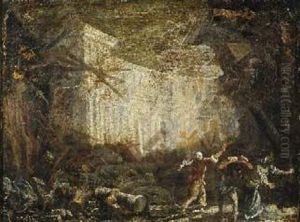Jacopo Chiavistelli Paintings
Jacopo Chiavistelli was an Italian painter of the Baroque period, born in 1621 in Florence, Italy. He is not as widely known as some of his contemporaries, but he contributed to the rich tapestry of Baroque art in Italy during the 17th century. His work primarily involved frescoes and other large-scale decorative projects for various churches and buildings in Florence and its surrounding areas.
Chiavistelli was a student of Matteo Rosselli, who was a prominent Florentine painter of the time. Under Rosselli's guidance, Chiavistelli honed his skills in the art of fresco painting, which would become his most notable medium. His style was influenced by the dynamism and grandeur of the Baroque movement, which emphasized dramatic expression, rich colors, and a sense of movement in the artwork.
Throughout his career, Chiavistelli undertook numerous commissions for religious institutions, which was common for artists of his day. His frescoes often depicted scenes from the Bible and the lives of saints, designed to inspire the faithful and contribute to the devotional atmosphere of the spaces in which they were displayed.
Chiavistelli's work was characterized by a strong narrative quality, with an emphasis on clarity and legibility of the scenes he depicted. This was in line with the Counter-Reformation ideals that sought to communicate religious stories and values to the congregation in a direct and emotional way.
Despite his contributions to the art of fresco painting, Chiavistelli did not gain the same level of fame as some of his contemporaries like Pietro da Cortona or Giovanni Battista Tiepolo. However, his work remains an important part of the Baroque artistic heritage in Florence.
Jacopo Chiavistelli died in 1698 in Florence. His works continue to be of interest to art historians and enthusiasts who study the development of Baroque painting in Italy. Although his name is not as familiar as other artists from the era, his paintings offer valuable insight into the aesthetic and devotional practices of the period.
